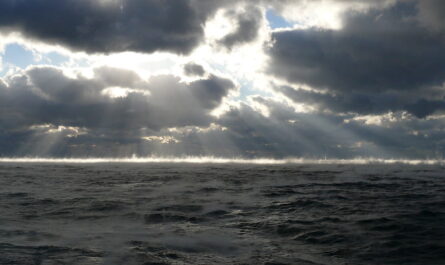Weather extremes, from heatwaves to heavy rainfall and severe storms, have profound impacts on ecosystems, economies, and human livelihoods. One of the critical drivers of these extremes in the Northern Hemisphere is the North Atlantic Oscillation (NAO). The NAO, a key climate phenomenon, plays a pivotal role in shaping atmospheric conditions over the North Atlantic Ocean and adjacent continents. Its influence on weather patterns spans from short-term variations to long-term climate trends, making it a subject of significant interest among meteorologists and climatologists.
This article delves into the science of the NAO, its mechanisms, its influence on weather extremes, and its implications for future climate scenarios.
What is the North Atlantic Oscillation (NAO)?
The NAO refers to the fluctuation in atmospheric pressure differences between the Azores High (a high-pressure system near the Azores Islands) and the Icelandic Low (a low-pressure system near Iceland). These pressure variations dictate the strength and direction of westerly winds across the North Atlantic, influencing weather patterns in Europe, North America, and parts of the Arctic.
Positive NAO Phase
- Characterized by a stronger-than-usual pressure gradient between the Azores High and the Icelandic Low.
- Results in intensified westerly winds that bring mild, wet winters to Northern Europe and colder, drier conditions to southern Europe and parts of the Mediterranean.
- Eastern North America often experiences colder and snowier winters under this phase.
Negative NAO Phase
- Defined by a weaker pressure gradient, leading to a meandering jet stream.
- Brings colder, drier winters to Northern Europe and wetter conditions to southern Europe and the Mediterranean.
- Eastern North America tends to experience milder winters during this phase.
Mechanisms Driving the NAO
The NAO is influenced by a complex interplay of atmospheric, oceanic, and terrestrial factors:
- Sea Surface Temperatures (SSTs):
Variations in SSTs in the North Atlantic Ocean affect the development of high and low-pressure systems, thereby modulating the NAO phase. - Arctic Oscillation (AO):
The AO, a broader atmospheric pattern, often aligns with the NAO. When the AO is positive, it strengthens the polar vortex, reinforcing a positive NAO phase. - Solar Activity:
Changes in solar radiation influence stratospheric temperatures, which can cascade down to affect surface pressure patterns associated with the NAO. - Human Activities:
Anthropogenic factors, such as greenhouse gas emissions and land-use changes, may also impact the NAO’s variability by altering atmospheric circulation.
Impact of the NAO on Weather Extremes
The NAO’s influence on weather extremes is far-reaching, affecting various regions differently depending on its phase.
1. Europe
- Positive NAO Phase:
- Brings warm, wet winters to Northern and Western Europe, leading to increased flood risks.
- Southern Europe experiences drought conditions, with reduced precipitation affecting agriculture and water resources.
- Negative NAO Phase:
- Northern Europe faces colder, drier winters, increasing energy demands and disrupting transportation.
- Southern Europe benefits from wetter conditions, replenishing reservoirs and reducing drought stress.
2. North America
- Positive NAO Phase:
- Leads to colder winters in the northeastern United States and Canada, with increased snowfall.
- The southeastern United States experiences milder, drier conditions.
- Negative NAO Phase:
- Brings milder winters to the northeastern United States and wetter conditions to the southeastern states.
3. Arctic Region
The NAO significantly influences Arctic sea ice extent and temperature anomalies. A positive NAO phase can accelerate sea ice loss by promoting warm air advection into the Arctic, while a negative phase may slow the melting process.
4. Tropical Regions
The NAO indirectly affects tropical cyclone activity in the Atlantic basin. A positive NAO phase strengthens the subtropical high-pressure system, steering hurricanes away from land, whereas a negative phase allows storms to track closer to the U.S. coastline.
The NAO and Long-Term Climate Trends
The NAO’s variability is not confined to seasonal or annual timescales; it also exhibits decadal and multi-decadal trends. Understanding these trends is crucial for predicting long-term climate changes and their associated impacts.
1. Historical Patterns
Studies of paleoclimate records, such as tree rings and ice cores, reveal that the NAO has oscillated between positive and negative phases for centuries. These historical patterns provide insights into natural variability and the potential influence of external forcings, such as volcanic eruptions and solar cycles.
2. Recent Trends
In recent decades, a predominance of the positive NAO phase has been observed, possibly linked to human-induced climate change. This trend has contributed to warmer winters in Europe and accelerated Arctic sea ice loss.
3. Future Projections
Climate models suggest that the NAO may become more variable in a warming world. Increased greenhouse gas concentrations could amplify the NAO’s effects, leading to more pronounced weather extremes.
Monitoring and Predicting the NAO
Accurate monitoring and prediction of the NAO are essential for managing the risks associated with weather extremes.
1. Observational Networks
Meteorological stations, satellites, and ocean buoys provide real-time data on atmospheric pressure, wind patterns, and sea surface temperatures, enabling scientists to track the NAO’s current state.
2. Climate Models
Advanced climate models simulate the NAO’s behavior under different scenarios, helping predict its short-term fluctuations and long-term trends. These models incorporate data on atmospheric circulation, ocean currents, and solar activity to improve accuracy.
3. Seasonal Forecasts
Seasonal forecasts based on the NAO index are valuable for sectors such as agriculture, energy, and disaster management. For example, a predicted positive NAO phase may prompt flood preparedness measures in Northern Europe and water conservation efforts in Southern Europe.
Implications for Society and Ecosystems
The NAO’s influence extends beyond weather patterns, affecting ecosystems, economies, and human well-being.
1. Agriculture
- Positive NAO phases can disrupt crop yields in Southern Europe due to drought, while Northern Europe may benefit from longer growing seasons.
- Negative phases bring wetter conditions to Southern Europe, aiding agriculture but increasing flood risks.
2. Energy Sector
- The NAO influences heating and cooling demands, with positive phases increasing energy consumption in Northern Europe during winter.
- Renewable energy production, such as wind power, is also affected by changes in wind patterns associated with the NAO.
3. Biodiversity
- Shifts in temperature and precipitation patterns impact the distribution and behavior of plant and animal species.
- Migratory birds and marine life, for example, adjust their routes and breeding cycles in response to NAO-driven climate variations.
Conclusion
The North Atlantic Oscillation is a powerful driver of weather extremes, shaping the climate of regions spanning the North Atlantic and beyond. Its influence on temperature, precipitation, and wind patterns underscores the interconnectedness of global weather systems.
As climate change alters the NAO’s behavior, understanding its mechanisms and impacts becomes increasingly vital. Continued research, improved forecasting, and adaptive strategies will be essential for mitigating the risks posed by NAO-driven weather extremes. By deepening our knowledge of this critical phenomenon, we can better prepare for the challenges and opportunities of a changing climate.



